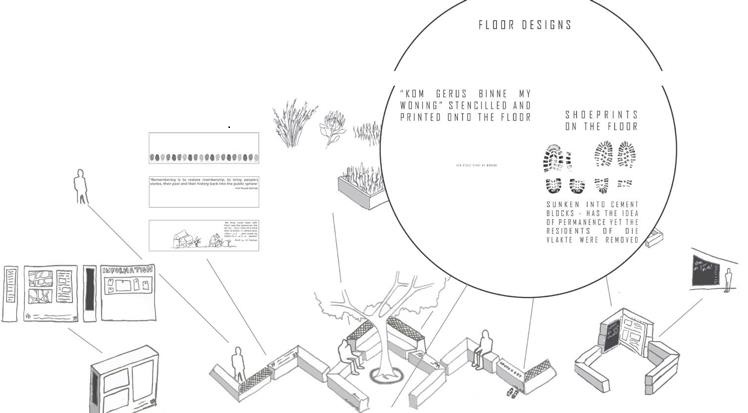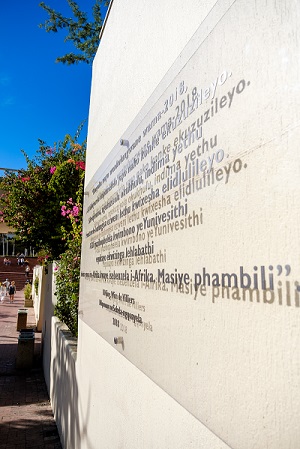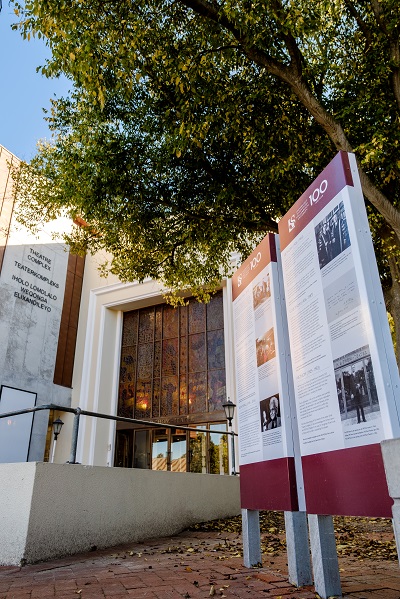Various changes and add-ons to the physical landscape of the campuses of Stellenbosch University (SU) will continue to appear over the next three years as several visual redress (VR) initiatives and the budget to implement them, were recently approved by the SU Council.
VR remains one of the main priorities of the University to transform the campuses into a more welcoming space for a multicultural campus community, says Dr Leslie van Rooi, Senior Director: Social Impact and Transformation.
“Changes to a campus environment can influence an institutional culture and must be seen as an important aspect for transformation to occur. The SU's visual redress project is to be expanded over the next three years (2020–2022) after the first phase of the project was successfully completed during the last two years (2018–2019," says Van Rooi, who chairs the Visual Redress Committee that is responsible for overseeing the visual redress processes, among others.
The following VR initiatives have been earmarked for the next three years:
- Contextualise existing statues and symbols on the campuses in collaboration with the various environments
- A history lane artwork envisaged for the area next to Wilgenhof Residence in Ryneveld Street (This will further connect the university with the town of Stellenbosch.)
- Garden project, allowing SU to express South Africa's heritage also through the gardens and other public spaces
- Visual representation linked to the cultures represented among the students residing in SU residences (including the University's Listen, Live and Learn [LLL] Villages)
- Develop Die Vlakte walkway and garden. This initiative, in collaboration with the Stellenbosch Municipality and residents of the historic Vlakte Community, will acknowledge the historic Die Vlakte community and the forced removals that had a dire effect on them.
- Workshops at various faculties about visual redress initiatives that can be undertaken by the faculties
SU's Facility Management (SUFM) is one of the main enablers of SU's visual redress project in public spaces on campus. Among other things, they are responsible for rolling out the new signage across the campuses.
“The redress project focuses on changing the University's landscape in an attempt to right the wrongs of the past and remedying the harm that visual symbols have caused. The new visual symbols have an African centrality. Not all the symbols will be changed and those that remain on campuses are put in the correct context," says Mr Francois Swart, Director: Development, Planning and Design at SU.
The Visual Redress Committee in collaboration with SU's Facility Management completed several additions or changes during 2018 and 2019, including:
• The Circle, a bronze art installation next to the Rooiplein, depicting eight women figures that symbolise the future of South Africa and leadership in the past, present and future.
• The sandblasted benches on the central Stellenbosch campus welcoming students, staff and members of the community in 15 languages
• A map of Die Vlakte, an area from where the Apartheid government removed families as part of the forced removals in 1964, has been affixed to the front door of the Arts and Social Sciences building in Victoria Road, Stellenbosch
• Special messages in Afrikaans, English and isiXhosa are on the walls of the University's library to acknowledge SU's role in the injustices of South Africa's past.

• Various maps of the broader Stellenbosch on the walls of the SU library
• Contextualising boards at the Adam Small Theatre Complex, Pieter Okkers House, the Rooiplein and the Faculty of Theology

• Visual redress workshops that took place at the Faculties of Law, Theology and Medicine and Health Sciences
Several people from the Faculties and the Professional Administration and Support Services (PASS), especially from the Department of Visual Arts and SUFM, form part of the Transformation Committee and participate in discussions and conversations about the physical landscape, planning, designing, creating signs, symbols, artwork, and the implementation thereof.
With the new visual redress initiatives becoming more visible SU takes in a new era. It is thus fitting that the current initiatives started in the SU centenary year. Van Rooi says research argues that visual redress may provide a means to attend to underlying, unspoken and unconscious expressions of exclusion that remain on the campuses of higher education institutions (HEIs) in South Africa today.
The SU visual redress project is a catalyst of the strategic themes of SU's Vision 2040 and Strategic Framework 2019–2040:
- A THRIVING STELLENBOSCH UNIVERSITY
Visual redress has a direct impact on a changing campus culture by adding new symbols, enhancing strong symbols and removing hurtful symbols.
- A TRANSFORMATIVE STUDENT EXPERIENCE
The new symbols are of a transformative nature and students are directly involved via workshops in commenting, choosing and building new symbols.
- PURPOSEFUL PARTNERSHIPS AND INCLUSIVE NETWORKS
Visual redress crosses institutional boundaries by liaising directly with other universities in forging new partnerships linking directly to what SU would like to achieve through visual redress.
- NETWORKED AND COLLABORATIVE TEACHING AND LEARNING
Visual redress, through workshops and through direct engagements with faculties, can enhance teaching and learning practices where students and lecturers can engage on contemporary issues in such a way that it leads to new symbols and/or removing hurtful symbols.
SU can lead research on the impact of visual redress processes on our campuses. In this regard, SU can collaborate with other institutions who have to deal with similar issues, gaining insight into some of the lessons learned.
An environment that is more welcoming allows staff members to flourish and to feel at home.

